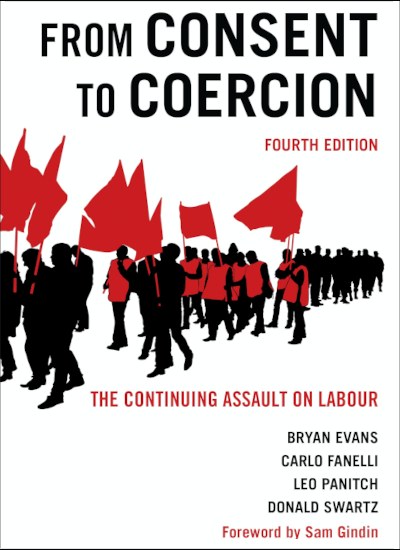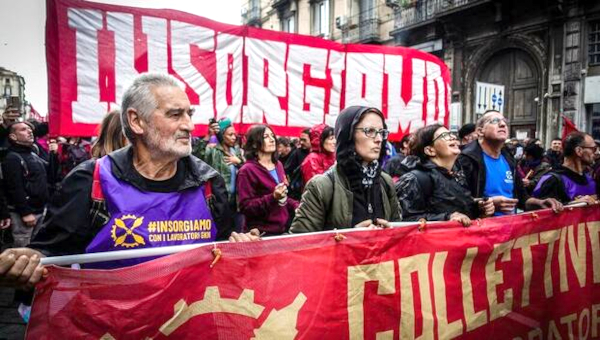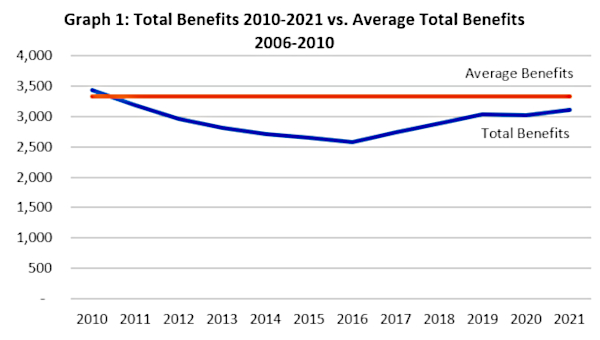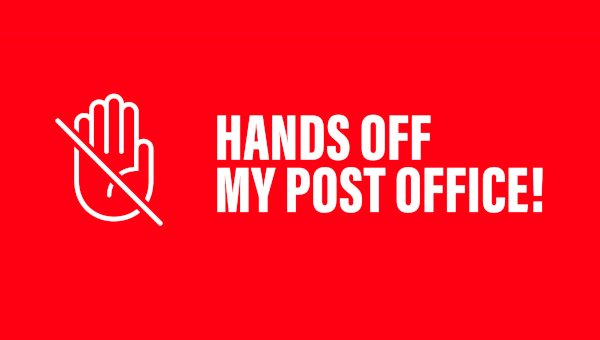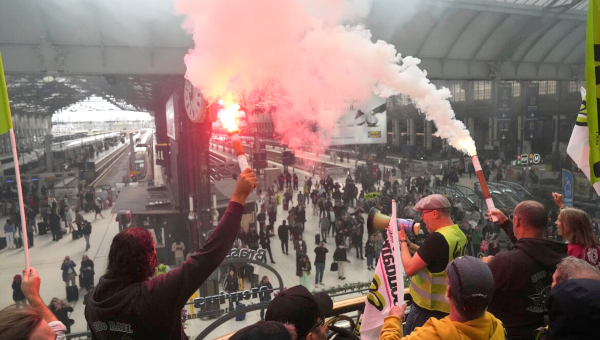The Air Canada/CUPE Fight and the Bias of Law: And why it is righteous and effective to breach the law
- In Canada, there are only two parties to a collective agreement: the employer and the union certified as a bargaining agent for some of that employer’s workers. Workers are not parties to any collective agreement which covers them.
- The two parties are allowed to use their economic power to force the other into accepting an agreement. The resultant agreement is, comically, said to be a voluntary agreement. It is therefore enforceable.
- As the union is a party to the collective agreement, it must not violate any of its terms and conditions. Unions do not work under the terms and conditions; workers do. Therefore, when a union is held responsible for violations, it is held responsible for workers’ actions. The union has an interest in ensuring that workers abide by the agreement’s terms and conditions. Primarily, the union must ensure that workers do not act in concert to directly protest conditions and terms of the collective agreement. Such protest and action must be left to be organized by the union when it and the employer are to engage in good faith bargaining. This variant of free collective bargaining de-emphasises the class-based struggle between bosses and workers and replaces it with a mediated scheme of struggle.
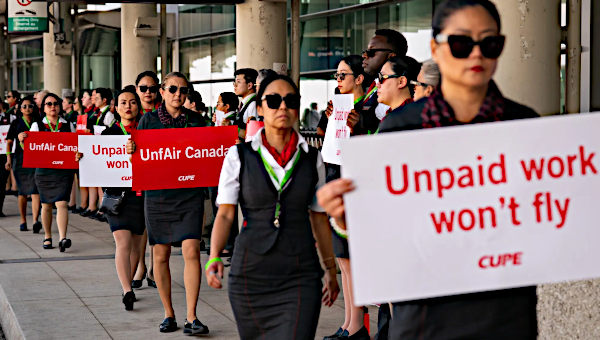
- When the time comes to wage flat-out economic war, the power of employers is their ability to go without production for a while. They are betting their loss of profits will be less hurtful than the loss of income for the workers. The union is betting that workers will be hurt less by their loss of income than will employers by their loss of profits.
Note the slippage of logic: workers, treated as third parties, as not central to the process of collective bargaining, turn out to be central to the calculations made by the parties to collective bargaining. - This system of free collective bargaining, with its potential to lead to lengthy impasses as employers and unions dig in their heels, is supported by conventional politicians, parties, policy-makers, and pundits. It is said by them that it is the best way to settle capital-labour disputes and that society might have to be tolerant and accept some inconveniences.
- But not too many.
- It turns out that, if politicians think that they will lose some political capital should they leave some inconveniences unredressed, they will look for ways to undermine their preferred system of free collective bargaining. They will force the disputants to renew normal production of goods and services, or more accurately, force one party to renew normal production of goods and services. Guess which one?
- Although there are two parties to collective agreement-making, the politicians routinely use their power to intervene so as to force workers to abandon their position. They will be required to stop withholding the only asset they have: their combined labour capacity. Of course, as workers are not, and cannot be, parties to any order to settle a dispute arising from an agreement, the government must order the union to retract its decision to ask the workers to strike. Note here that by the time that a union had told workers they could strike, the union had already jumped over a bunch of time-consuming and costly hurdles. It must give notices, go through a conciliation process, organize a vote among its members, apply for a No Board decision, and then give some more notice. Given all this, it is galling that, more often than not, workers (not the union) are required to go back to work for their recalcitrant employer on the terms and conditions that their union had every right to reject when it took its members out on strike. This happens so often that most people think that this is the only logical way to deal with impasses.
- By the 1980’s, Panitch and Swartz reported, Canada had moved, almost seamlessly, from legislative wage control to a systematic assault on trade unions. Federal and provincial governments of all political stripes justified the restrictions on organized workers’ strike rights with the argument that the self-seeking behaviour of one bargaining unit of workers should not be allowed to interfere with a government’s democratically undertaking to deliver services to Canadians. Various tactics were deployed: prohibitions on some workers from ever striking, like health workers or the police; designating (before or during a strike) some workers as essential, permitting them to deliver services during a lawful strike by their colleagues; or calling the legislature together to order selfish workers back to work on conditions and terms they had had a legal right to refuse. An arbitrator would be called-in to impose an agreement. What Panitch and Swartz documented was a rather extraordinary set of developments, given the persistent clamour by the elites that they truly believed that compulsorily imposed agreements, which they were increasingly endorsing, were the wrong way to go.
- All these efforts to minimize workers’ strike rights were supported by the Supreme Court of Canada’s reading of the Charter of Rights, which had been embedded in the constitution by then. That Court refused any claim by workers that the guarantee of freedom to associate, which allowed workers to form unions, should also include the right to bargain collectively and to strike. In the absence of such rights, workers argued, the freedom to form a union was a hollow one. It took 28 years, much litigation, money and, of course, reduced living conditions for workers, before the Court saw the logic of this workers’ argument and changed its position. In 2015, it said that we could disregard all it had ever said on the issue. Now the right to strike was to be a protected right, just as workers had always claimed it was.
Note: It is passing strange, then, that unions and their advocates are now having to look to that judiciary – which, historically, has set its face against workers’ collectivism – for help against elected governments.
- Despite the turnabout by the Supreme Court of Canada, the spiteful approach to unions and workers has not lost its vigour. A 4th edition of Panitch and Swartz was put out nearly four decades later, in 2023, by Bryan Evans, Carlo Fanelli, et al. It reported the continuing attacks on trade unions involved new techniques. The Air Canada/ CUPE confrontation is just the latest manifestation of this pattern of anti-union governmental behaviour. New techniques were necessitated because the 2015 Supreme Court of Canada would force legislators to override the Charter of Rights and Freedoms every time they resorted to back-to-work legislation as they had done so often before 2015. That would have been politically difficult.
- The federal government turned to the Canada Labour Code (CLC), which has provisions that allow the Minister of Labour to refer matters to the Act’s oversight body, the Canadian Industrial Relations Board (CIRB), whenever a problem is seemingly unresolvable by the parties themselves. They are counting on that agency to enfeeble whatever stance a union has taken. Governments are behaving a bit like tax avoiders: they have set out to find a provision in a statute that renders one of the statute’s explicit goals (here to legitimate a limited right to strike) unachievable. As they set out to repress unions and workers, they are hoping that no one will notice that they are sneakily overriding the Charter rights workers were finally given in 2015. The reasoning by these cunning governments is that, when that strike right protecting decision was made, the Court had not ruled that any kind of strike was protected but rather only the kind of strike already protected by the CLC (or its provincial equivalents). Thus, if the Minister merely asked or directed the CIRB to make a decision that the CLC gave it power to make, the government would in no way be responsible for undermining the right to strike: the CLC itself envisaged that it could be restricted by its agent, the CIRB. Nothing the Charter protects would be imperilled, as the right to strike as defined by law was being honoured.
Note: several unions have brought actions to the courts to ask them to hold that these attempted end-runs around the Charter are invalid. I believe they may well succeed. Some judges are likely to be disappointed that our governments could sink to the level of the crass and greedy rich people who routinely use the letter of the law in order to negate its spirit an, thus, avoid taxes. But it will be quite a while before we know. - The federal government has disinterred three sections in the CLC that were thought to have been dead and buried: Sections 107, 108, and 108.1. Section 107, the one used rather frantically by Liberal governments to undermine workers’ legal engagement in work stoppages in a railroad dispute and in various ports in Quebec and British Columbia, provides that the appropriate Minister may direct the CIRB to settle an impasse when an on-going strike and/or lock-out needs to be brought to an end to maintain industrial peace and stability. Each time the Minister made such a reference, the CIRB was asked/directed to stop the workers from striking and to offer an alternate dispute resolution mechanism.
Note the deceit: formally the government was not interfering with the right to strike. This, of course, was the approach used by the Minister for Jobs and Family (a telling title deliberately chosen to replace “Minister of Labour” by Carney) in the Air Canada/CUPE case. In the Canada Post strike, the government used Sections 108 and 108.1. Section108 allows the appointment of an Industrial Inquiry Commission when a Minister thinks things look dire because of a lawful work stoppage made worse by a countering lock-out. The idea that a rational, objective inquiry will lead to a decent settlement is curious, given that the ideal resolution mechanism, free collective bargaining, is posited on a battle of economic strength, not objective reasoning. In any event, how objective an Industrial Inquiry will be depends on who the inquirer is and on the frame of reference given to them. In the Canada Post case, it is fair to say that the inquirer’s report favoured the position of the employer heavily, strengthening its resolve not to give an inch. This provides us with a bridge to Section 108.1. It gives employers the right to put their last offer directly to the workers if their union has rejected it. This is meant to undermine the union’s standing with its members and create apprehension inside the union, making it more willing to be flexible to avert such a vote. In the Canada Post case, the anti-worker report made by the Industrial Inquiry emboldened the employer to put its last miserable offer to the union to workers directly. Fortunately, the workers rejected it, leaving the union with leverage to renew negotiations. But they are in a weakened position because the Inquiry report, written by a well-known arbitrator William Kaplan has hardened the employer’s stance. The union may well have to seek an alternate resolution, as, from an outsider’s perspective at least, its hope to get public support for a strike (which the flight attendants had) is dim.
Note: Section 108.1 suggests that the collective bargaining scheme envisages that, for some purposes, workers should be treated as direct parties to all these proceedings, rather than be treated as problems to be managed. - The use of section 107 would be less of a problem if it was used to bring the employers to heel. Currently, it is always used to order the workers to stop their strike (as were all the back-to-order statutes passed pre-2015). Why not order a stop to the lock-outs in which employers indulge themselves? After all, these strategies are deployed to alarm the government, to indicate that, even though the worker-induced stoppage has only lasted a day or two, national chaos (and strangely, as raised by Minister Hadju in the Air Canada case, a win for Trump) will ensue, now that there is both a lawful strike and a lawful lock-out. The increased use of a lock-out in response to a union’s exercise of strike rights has proved to be a sure way to get the anti-worker Liberal Party government to invoke Section 107 (and 108, 108.1, or all three). But, to return: why not direct the CIRB to order the employers to end their lock-out and to resume normal production of goods or services on the last terms and conditions asked-for by the union on behalf of its members? Surely, the workers would go back and, if not, the employer might prove more flexible when negotiating. Either way, the government would have an excellent chance of avoiding national chaos or even a Trump win. Here, let us remind ourselves that there are two parties to an agreement and, therefore, to the dispute. Why should it seem natural that one party’s use of economic coercion, the union, should be deterred rather than the other party, equally bent on flexing its economic muscle as vigorously as possible?
- To ask this question is to answer it. The Air Canada/CUPE labour dispute was the eighth time since 2024 that a Liberal federal government (led by Trudeau or Carney) resorted to the sleight of law (which is what the deployment of sections 107, 108, 108.1 really is). Each time, the Ministers had their fingers hovering over the “start” button, waiting for the employers to give them the signal to push the button. Each time, the unarticulated but firmly held underlying world view, was the same. The owners of the means of production are crucial to the creation of our overall welfare, and we must make sure that they will invest and stay invested. We must clamp down on anything which might upset them. And what upsets them most of all? Fight-backs by the working class. They fear them. A tiny bit of proof is in the eating of the pudding. In the Air Canada/CUPE struggle, the workers refused to be bound by the law used to clamp down on them. They called the use of the law, Section 107, invalid and continued their strike. Within hours, seeing their determination (and possibly the merit of their legal claim), Air Canada was back at the table, which it had left in high dudgeon on the basis that mere workers (mostly women) should not be allowed to defy them. A deal was reached. It is an important lesson.
- Historically, our notion has been that those who own the means of production are free to use them, decide how to use them, or to not use them at all. In a society where wealth is grossly unequally divided, this gives the owners of the means of production immense coercive powers, economic and political. In Canada, our legal system purports to be a liberal one, but it also maintains and perpetuates capitalist relations of production. Hence, while one of its starting positions is that law will treat all individuals as sovereign equals, by which it means that not one of them is allowed to tell any other of them how to think or act, it has another conflicting starting position as well. This is that individual property owners who have power to coerce us and governments must be allowed to do so if they do it by exercising their (seemingly God-given) right to use their property as they choose. Economic coercion by them, exercised as individuals, is not offensive to our liberal legal system. But it does materially subjugate those without discretionary wealth, who therefore need to combine to exert some countervailing power. They must form unions. This is anathema to the credo of the individual which law purports to safeguard. For individuals without discretionary property to combine, to collectivize their only wealth, namely their bodies and minds and their labour capacity, in order to get a better deal, is a serious violation of law’s liberal principles and society’s constructed ideology. The right to form unions, to bargain collectively, to strike, has been resisted all the way. Law has been at the beck and call of those anti-worker forces. It still is, as this sketch of the Air Canada/CUPE saga has shown.
- All this is made more upsetting because law has to twist and turn to help out individual property owners. In each of the cases considered above and, indeed, in most important capital-labour struggles, the employer is treated as an individual when it clearly is not. That is, the privilege of individuals with wealth to do with their property as they choose, even to coerce, should not be available to these employers. All of them are corporations. Functionally, they are legal envelopes in which human beings invest some of their discretionary capital. That is, the property held inside that envelope which, the law says belongs to the corporation is an aggregation of separate wealth owners’ property. These owners have combined their capitals. They do this to give themselves more coercive power than they could exercise as discrete owners of some of the means of production. In principle, liberal law should fight-off this search for more economic and political power by the formation of a corporation as, historically it has done to restrain the formation and legitimacy of trade unions. It does the opposite. It enters into a game of pretence. It treats a corporation as a separate individual, separate from the contributors of capital, from its workers, from all on earth. It is, says legal pretence, an ordinary individual, like a human being and, thus, not a functional combination of capitals or an instrument used by a combination of people. For law to facilitate and promote the coercive powers of wealth owners while it frowns on the formation of unions because of the potential of combining workers to coerce individuals tips the starting scales when employers and workers enter into bargaining in the employers’ favour. The structural and ideological fix is in. Courts have been instrumental in crafting a privilege for corporations and building a bulwark against effective workers’ combinations, that is, trade unions with strike right. This, and not legal reasoning, is what explains why it took the Supreme Court of Canada 28 years to say that the workers’ freedom to associate must include the right to bargain collectively and to strike, a self-evident proposition if there ever was one.
- The dice are loaded, especially the legal ones. The law provides the structural basis for capitalism, and most importantly the sacrosanct nature of private property ownership, the ideology to help make capitalism look normal and, finally, the instruments to ensure that the structural and ideological status quo will not be disturbed too much by providing mechanisms of adjustment that help contain the working class’s inevitable resistance to its subjugations and indignities as capitalists exploit their powers.
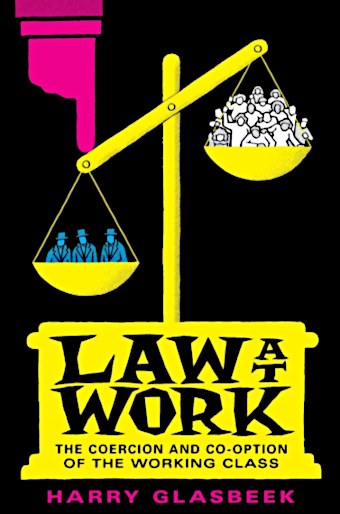
- It is hoped here that the recent oh-so-obvious abuses of legal loopholes by greedy corporations remind Canadian workers that there is a class war being fought from above.
Note: The intensification of government supported attacks on trade unions in government and quasi-government settings should be seen as being related to the fact that the statutory collective bargaining we have was designed for industrial actors in the private sector. Today, only 15% of private-sector workers are unionized. The overall unionization rate in Canada is just around 30%, meaning that the governmental sectors are where the unions are, where the class war from above has most salience. In addition, the new Carney government has announced that each government department must look for substantial cuts, something that is bound to give rise to labour unrest. De-toothing unions must seem attractive to the Carney government. As long as unions and the workers they represent battle with employers from within the sophisticated compromise – which is what our statutory collective bargaining scheme is – they will be fighting with their hands tied behind their back. - Unions should not have to tell the workers how to behave. Workers should be more than only indirectly involved in the setting of their conditions of work. Ideally, for the working class, the class war being waged on them should become a class war in which they consciously participate and fight. While the penalties for not following the strictures of law may be harsh and no one can ask workers to make sacrifices for the greater good, it should, after the abuses of legal instruments discussed here, be clearer than it already was that workers are involved in a ceaseless existential war and that, at the right moment, the collective repudiation of restrictive laws is righteous and effective. •


